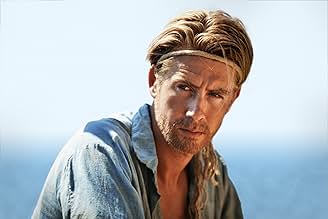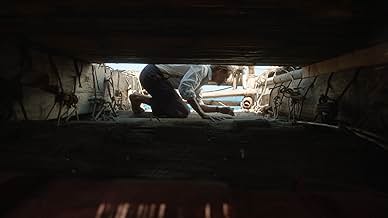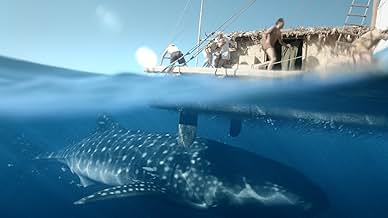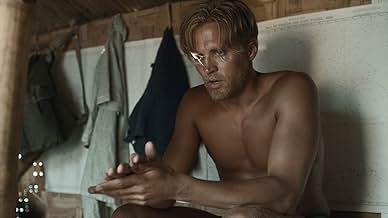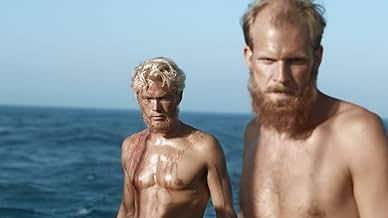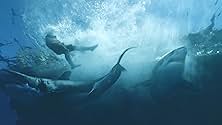Die epische 6.900 Kilometer lange Reise, die der legendäre Entdecker Thor Heyerdal 1947 auf einem Floß aus Balsaholz quer über den Pazifik unternahm, um nachzuweisen, dass es für die südamer... Alles lesenDie epische 6.900 Kilometer lange Reise, die der legendäre Entdecker Thor Heyerdal 1947 auf einem Floß aus Balsaholz quer über den Pazifik unternahm, um nachzuweisen, dass es für die südamerikanischen Ureinwohner in der Zeit vor Kolumbus möglich war, Polynesien zu besiedeln.Die epische 6.900 Kilometer lange Reise, die der legendäre Entdecker Thor Heyerdal 1947 auf einem Floß aus Balsaholz quer über den Pazifik unternahm, um nachzuweisen, dass es für die südamerikanischen Ureinwohner in der Zeit vor Kolumbus möglich war, Polynesien zu besiedeln.
- Regie
- Drehbuch
- Hauptbesetzung
- Für 1 Oscar nominiert
- 12 Gewinne & 14 Nominierungen insgesamt
- Thor Heyerdahl
- (as Pål Hagen)
- Herman Watzinger
- (as Anders Baasmo Christiansen)
- Thor 6 yrs.
- (as Kasper Ameberg Johnsen)
Empfohlene Bewertungen
This is the story about the amazing world famous Kon-Tiki trip crossing the pacific on a balsa-raft just to prove this happened in ancient times, made by the makers of great Max Manus.
The trip, taken on the basis of an idea of the explorer Thor Heyerdahl, was completely ludicrous and no one believed it could be done. and how could a trip like this be told better than by Heyerdahl himself in the documentary made during the trip.
Back in 1947 this was just the story the world wanted to be told after the 2nd world war and the atomic bombings of Hiroshima and Nagasaki. The documentary film from the trip later won Oscar (1951), and the book was translated into 70 languages, and sold more than 50 million copies world wide.
Finally we get to see the trip dramatized as it should be. And the result is really an amazing and epic film which holds two hours of explorer-ism, excitement and awe. I think we really get to imagine how it was to be 6 persons floating on an uncontrollable raft in the middle of nowhere for more than hundred days. The bore, the awe of discoveries, the fear of weather, sharks and whales. The psychological toll, the friendship...
It's a great story and a great film which will make new generations pick up the book with the same name, before they watch the original documentary. Beautifully filmed, well played, even down to Heyerdahl incredibly bad English pronunciation. Not all is accurate. There's been a debate around the premiere about making Herman Watzinger such a wimpy character, when we actually was a Norwegain 100 m record holder and a strong guy with good looks, but the writers found the story needed heart, and not only bald and crazy feeling-less young men. I agree. Over 100 days on a raft is at least 90 days of boredom.
Thor Heyerdahl himself made this trip to prove his idea, which no one would believe, and later got famous. He made the trip though he was not only not able to swim, but actually afraid of water, can you imagine! And it also tells the story of those left behind, wife and kids.
This is the most expensive Norwegian film production ever, and the story is a Norwegian sacred explorers story, as good as they come, changing world history. Thankfully the film floats as good as the raft, and is well wort ha watch. Great manuscript, beautifully filmed, good handcraft.
The film comes in both a Norwegian and an international (English) spoken version, which gives the movie a possibility to be shown all over the world. And it will. Treat yourself to an insane, but epic trip, and get to be an explorer yourself. This is great storytelling! It loses one of 10 stars due to the irritating (though factual) English pronunciation of Heryerdahl. Not necessary to re-experience that to make a good story.
The film began with Thor as a child when he fell into the icy lake and almost drowned. However we later find out that that accident and his inability to swim did not deter his adventurous spirit. We fast forward to Thor and his wife Liv on Fatu Hiva, a Polynesian island, in 1937. There he learned the belief of the islanders that their ancestor Tiki actually came from the East (the Americas) instead of Asia as commonly assumed.
For several years, Thor tried to get his theory about Polynesian origins published but was repeatedly rejected. Therefore, he resolved to prove his theory by recreating Tiki's original ocean journey from Peru to Polynesia on a raft made of balsa wood (with strictly no modern materials).
It is just too coincidental that I am watching another ocean adventure just a few days after watching "Life of Pi." Kon-Tiki traveled the Pacific in the opposite direction that Pi did. It had an experienced though spare crew of 5, composed of two sailors, an engineer, an ethnographer and Thor, so it had a distinct advantage over the teenager and a tiger.
But maybe because I just watched Pi, maybe I expected to see so much more maritime misfortune than I did with Kon-Tiki. However, that sequence with vicious sharks had real heart-stopping suspense. I do have some misgivings about that episode with the whale shark, because it is not really the aggressive creature depicted in the film.
This was a straight-forward adventure film for the family. It may seem old-fashioned to some, nothing too controversial or strange as one can expect from modern European cinema. It was by no means boring, but I admit I felt like it lacked a certain edge while I was watching it. The crew members did not even have any significant conflict among each other and they were trapped on a raft for a hundred days! That may come across as unbelievable in these days of Big Brother and other "reality" TV shows.
I do hope I can find myself a copy of the 1950 Oscar-winning documentary about the real Thor Heyerdahl, his crew and their 101-day oceanic ordeal. That should be very interesting indeed.
Anyway, even though I have not watched nor have any knowledge of the original, I am impressed with the way this film was made. It was pretty well-balanced with no major flaws in my opinion. Well acting performances by the cast were complemented by a high level of cinematography technique that made looked like the entire journey on the raft was really shot wide in the ocean. Like Life of Pi, there were certain marine animals that were infamously being shown from the real life account of Kon-Tiki, and the CGI made on the animals were so real you probably cant tell if those animals were fake.
Probably the major point of improvement that the film can work on is the lack of character development of the other participants in the Kon Tiki, aside from Thor Heyerdahl himself. I am not implying there was none, as we get to see Thor's mates conflicts happening from the start till the end, but I wish I could have known more why they decided to join and their background story. Understandably, with the time given the film had chosen to focus on Thor instead with a lot of plot material explaining why he had to venture into such a journey.
I was also curious if there were more that could be shown about a group of men enduring a raft journey across the ocean in +100 days. But overall, just by solely comparing the similarities, this is much better and believable than Life of Pi as well as a very satisfying movie experience.
I'm not saying this just because I'm Norwegian and extremely proud that my country managed to produce this amazing adventure. Kon-Tiki is definitely one of the most original, well- written and fun films I've seen this year.
It's the 1940s. Without spoiling the story (which is real by the way), we are invited to follow Thor Heyerdahl as he gathers a crew of overly confident Scandinavians attempting to cross the Pacific on a balsa wood raft. All in the name of science and a boyish thirst for adventure! This attitude is understandable; after enduring the misery of WW2, little seemed more tempting than escaping to faraway exotic lands. Bravery or stupidity? In either case, viewers can look forward to one hell of a boat ride.
What I adore about Kon-Tiki is the presentation of the raft's surroundings. The Pacific Ocean is just as magnificent and beautiful as it is dangerous and merciless, and this dynamic is perfectly balanced. Peaceful waters and clear skies suddenly give way for dangerous sea- creatures and storms mighty enough to tear the old-fashioned raft apart. Kon-Tiki is simply grand. At times my adrenaline rose, my heart started pumping, and I started lusting for adventure myself - just by watching.
Another strong point is the cast. The actors do a brilliant job at depicting the slightly eccentric yet adventurous Scandinavians far away from their Nordic comfort zone. Thor Heyerdahl is particularly well portrayed with his dreamer-like attitude and awkward English skills. Although I would prefer more emphasis on character development, Kon-Tiki make them just interesting enough for viewers to care for them.
Kon-Tiki is such a delight to watch, because it's original, different and not your typical Hollywood adventure flick. No, the plot is not complex. It has no twists or turns, and Kon-Tiki certainly doesn't contain the amount of drama you'd expect. And this is what makes it good - the film is all about the sheer excitement of the adventure. Of course it isn't perfect, but for a Norwegian film, I'd say it holds its ground rather strongly.
I honestly haven't had this much fun with a film for a long while. If you're lucky, Kon-Tiki might show up on a festival or international cinema near you. In that case, do watch it.
Beautiful cinematography...including magnificent scenes of whales & sharks circling the raft.
Character studies of Thor Heyerdahl & his companions on the journey are intelligent subtle portrayals. Thor is one driven man, from almost drowning in childhood to landing on the beach on Roraia, Indonesia. Thor spent ten years with his theory that Polynesia was settled from Peru; not from Asia, the settled hypothesis at the time. Final proof came via the 1947 voyage on a raft using the same 1500 year old techniques of navigation and raft construction. While this may sound a bit dry, it is not. The passion of the participants is palpable. Each has their own reason for going on the journey; most simply falling under Heyerdahl's charisma. (Heyerdahl's 1950 documentary won the Academy Award, and remains the only Norwegian winner of an Academy Award to date.)
Though not cast based simply on physical looks (per the co-directors), several are magnificent specimens of blond 1940s fit men...and their bonding.
Every scene was filmed first in Norwegian, then in English; (US release of the English version seen is expected by the Weinstein group later in 2013.) Filming was 59 days in six countries. Audience reaction of the PSIFF screening was loudly appreciated followed with Q&A with the co-directors.
Wusstest du schon
- WissenswertesLarge parts of the film were filmed in two versions at the same time, one in Norwegian, the other in English, in order to secure international funding. See ALTERNATE VERSIONS section for greater detail.
- PatzerThe crew were not worried about whether the ropes would hold the float together, as it is portrayed in the film. As we can see in the Kon-Tiki (1950) documentary, the balsa wood was much softer than the rope, and it was actually the rope that ate through the wood. The result was that the rope eventually was protected by the space that had been created around it.
- Zitate
Epilogue: Bengt fell in love with Polynesia. He settled there and became a Consul General of Sweden. He died in 1997.
Epilogue: Erik built himself a sailboat, that became his home for 11 years. He worked as an artist until his death in 1972.
Epilogue: Torstein kept going on expeditions. He died in 1964 during an attempt to reach the North Pole on skis.
Epilogue: Knut resumed his career in military intelligence. He was also instrumental in the establishment of the Kon-Tiki museum. He died the Christmas of 2009.
Epilogue: Herman became the director of UN's Food and Agriculture organization. He died at Titica lake in 1986.
Epilogue: Thor wrote a book about Kon-Tiki. It was translated to over 70 languages, and sold over 50 million copies. The documentary about the expedition won an Oscar. Liv and Thor divorced after the Kon-Tiki expedition. Their boys lived with Liv, who later moved to the US where she died in 1969. Thor continued his work as an experimental archaeologist, author and explorer. He died in 2002.
- Crazy CreditsBefore the closing credits, short clips are shown in which original footage shot by Heyerdahl was reenacted by the "Kon-Tiki" actors: urinating overboard in the open sea, dancing with natives under palms, portraits, and the like. Along with this, brief notes concerning each crew member's path of life after the trip are given.
- Alternative VersionenIn an unusual technique, the film was shot simultaneously in both Norwegian and English, with each scene being filmed twice, first in Norwegian and then in English, with the same actors. This resulted in two versions of the film to be released, one primarily for the Norwegian domestic market, the other for an international audience. In a few cases, such as action scenes and computer-generated sequences, they used the same shot, later adding English with dubbing.
- VerbindungenFeatured in 70th Golden Globe Awards (2013)
- SoundtracksFlickan i Havanna
("The girl in Havana")
Lyrics by Evert Taube (as Taube) and music by Horatio R. Palmer (as Palmer)
Top-Auswahl
Details
- Erscheinungsdatum
- Herkunftsländer
- Offizielle Standorte
- Sprachen
- Auch bekannt als
- Thor Heyerdahls Kon Tiki
- Drehorte
- Nu Boyana Film Studios, Sofia, Bulgarien(New York exterior scenes)
- Produktionsfirmen
- Weitere beteiligte Unternehmen bei IMDbPro anzeigen
Box Office
- Budget
- 16.600.000 $ (geschätzt)
- Bruttoertrag in den USA und Kanada
- 1.517.410 $
- Eröffnungswochenende in den USA und in Kanada
- 22.168 $
- 28. Apr. 2013
- Weltweiter Bruttoertrag
- 22.842.887 $
- Laufzeit1 Stunde 58 Minuten
- Farbe
- Sound-Mix
- Seitenverhältnis
- 2.35 : 1
Zu dieser Seite beitragen






